The Extraordinary World of Blue and White Pottery
Our much anticipated blog, and a celebration of Dutch Delft, is finally here. During the very successful guided tours of our antique centre earlier this month, we saw a heightened interest in all things blue and white.
In particular, we saw a lot of interest for Dutch Delft, which denotes pottery produced from Delft in the Netherlands. In this country much of their wide spread celebrity comes from their English Transfer-ware cousins, which we can find in many museums and National Trust country house collections.
Tin-glazed pottery was made in the Netherlands from as early as the 16th century, with the finer works produced in Delft, but it was the trade with the East through the Dutch India Company that imported millions of pieces of Chinese porcelain in the 17th century that inspired awe in the western audience and triggered a true mania for its blue and white ceramics and works of art.
Distinctive for the cobalt blue design on a white background and with its superb workmanship and attention to detail, it originally captivated an exclusively wealthy market. Soon trade started going the other way, with royalty and wealthy, commissioning designs that were send to China to be made into a multitude of objects, and which together with the contemporary taste in tea, coffee and hot chocolate, completed an ensample of status symbol items and practices.
It became truly global when during the civil war in China in the middle of the 17th century, Japan stepped in picking up trade and craftsmanship by copying many of the Chinese designs and selling them back to Europe. Meanwhile, potters in Europe trying to emulate it kept the production active with the town of Delft becoming the most famous centre with this type of ceramic influenced by Italian Majolica and finding its way into England.
Here is a wonderful selection of Delft Blue that we've recently spotted in Grays...
Rare Dutch Delft lobed dish, decorated in under glaze blue and green and yellow enamels with a portrait of Queen Mary within a border of yellow tulips and green and blue foliage. Offered by Guest & Gray
Dutch Delft blue and white double gourd vase, circa 1700, decorated in the Wanli style with shaped figure panels. Offered by Guest & Gray
Dutch Delft wall plaque, circa 1730-40, decorated with a figure of Flora standing on an ornate plinth flanked by attendants seated in chariots, all within a moulded and shaped border of flower heads on a dark blue background. Offered by Guest & Gray
Large Dutch Delft faceted baluster vase and cover, circa 1700, decorated in the transitional style with figurative scenes of warriors with an attendant in a landscape of rockwork and trees, beneath a border of jui shaped lappets containing stylised flowers, all above a border of cartouches containing flowers alternating with stylised flower heads, further border at the base with stiff leaves, the faceted domed cover with similar borders. Offered by Guest & Gray

Pair of 18th century white Dutch Delft horses, cold painted, with moulded saddles and bridles on a plinth. Offered by Guest & Gray
18th century Dutch Delft jar of baluster form, painted with a large intricate cartouche, surmounted by an urn of flowers. The word Duinkerker inscribed across. Offered by Anita Gray
18th century Dutch Blue & White Delft apothecary jar of high shouldered cylindrical form finely painted and decorated with the inscription. Offered by Anita Gray
Early 18th century Dutch Delft Jar of squat baluster form with slightly everted rim, decorated with an elaborate cartouche inscribed 'Straasburg', the cartouche with floral decorations dotted and diaper patterning
Offered by Anita Gray
For more information about Dutch Delft visit:
Written by Titika Malkogeorgou







.jpg)

Comments
Post a Comment